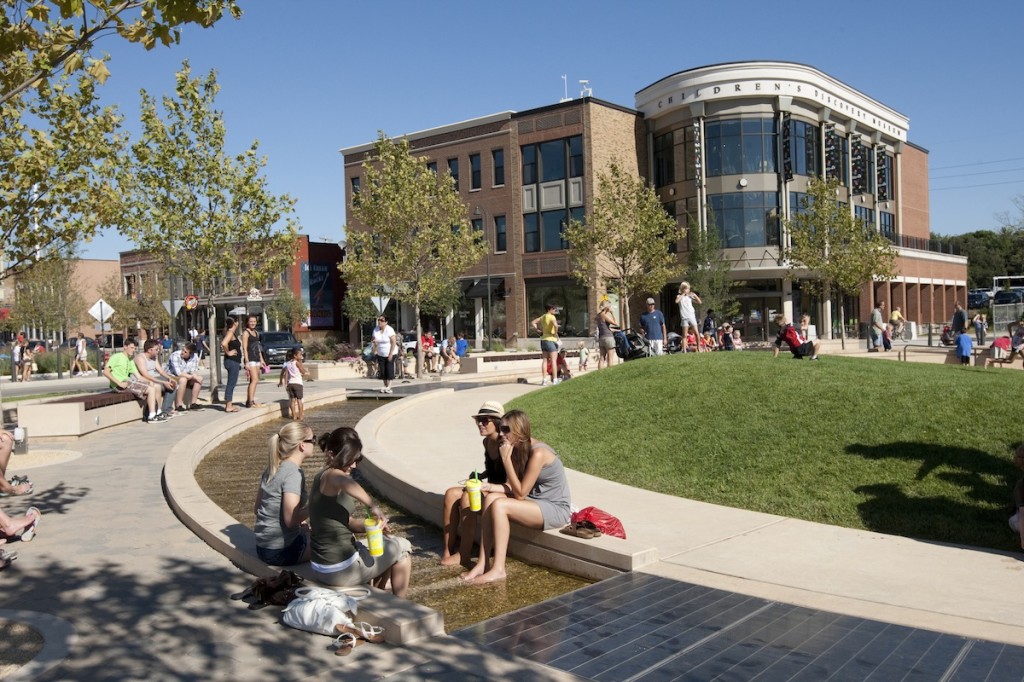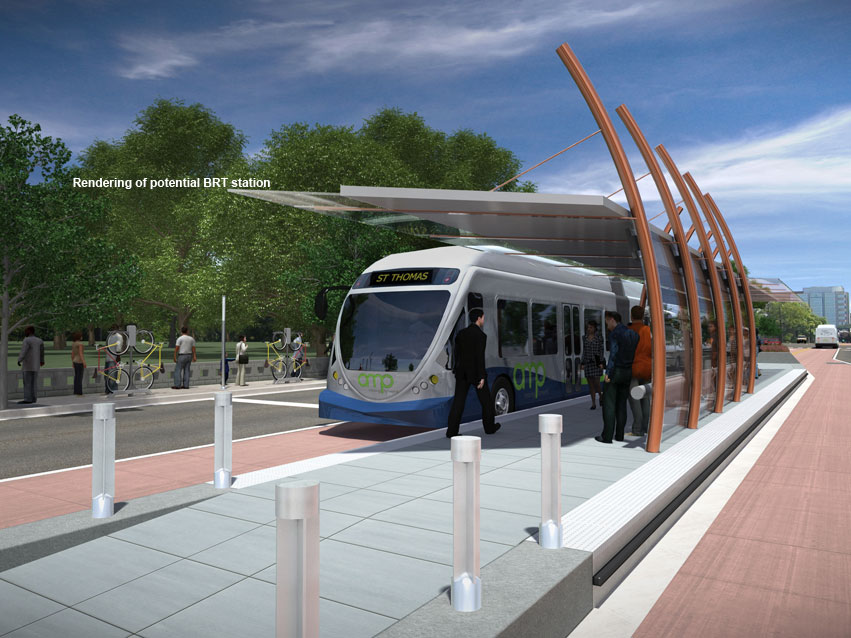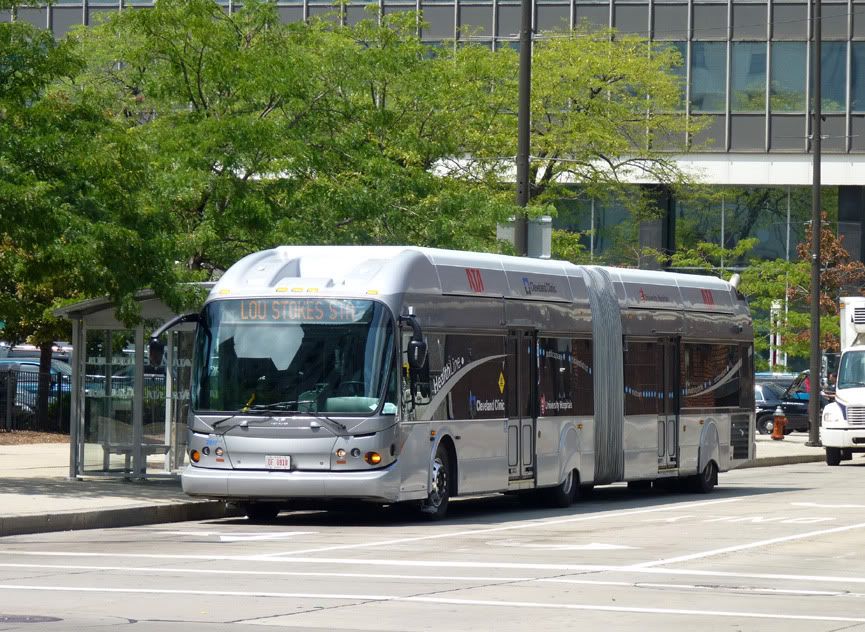Author's posts
Jun 02 2014
Sunday Train: A “Bipartisan” Transport Bill You Can Support
 For me, when I hear the word “bipartisan”, my first reaction is to brace myself to confront a piece of corporate mischief making being peddled under the excuse that there is some other piece of corporate mischief making that is even worse and this bad policy will stop … or sometimes just delay … that even worse policy from being implemented.
For me, when I hear the word “bipartisan”, my first reaction is to brace myself to confront a piece of corporate mischief making being peddled under the excuse that there is some other piece of corporate mischief making that is even worse and this bad policy will stop … or sometimes just delay … that even worse policy from being implemented.
However, since the appeal came from Transportation for America, I was willing to keep reading and see what was in it:
Most taxpayers would agree that the level of government closest to the people should have more control over how transportation dollars get spent in their local communities. Yet local cities, towns and counties control less than 15 percent of all federal transportation dollars.
If you think that needs to change, then stop what you’re doing and ask your representatives to cosponsor this critical, bipartisan bill. It would give local communities more access to federal transportation funds that they can invest in homegrown transportation plans and projects that they control.
Join me below the fold to have a look and a think about this proposal.
May 12 2014
Sunday Train: GOP Transport Bill proposes to Cut That TIGER
 I guess Sunday Train did not cover the White House transport proposal, which put forward a $302b 4-year surface transportation authorization, more than $20b per year higher than current levels. With respect to rail funding, it proposed reorganizing intercity passenger rail funding into Current Rail Service and Rail Service Improvement programs, merging the Amtrak funding which was authorized in FY 2013 and 2014 with the Higher Speed / High Performance rail program which was zeroed out in the funding that passed Congress.
I guess Sunday Train did not cover the White House transport proposal, which put forward a $302b 4-year surface transportation authorization, more than $20b per year higher than current levels. With respect to rail funding, it proposed reorganizing intercity passenger rail funding into Current Rail Service and Rail Service Improvement programs, merging the Amtrak funding which was authorized in FY 2013 and 2014 with the Higher Speed / High Performance rail program which was zeroed out in the funding that passed Congress.
For the 2015 budget year, it proposed:
- for Federal-Aid Highways an additional $7.1b (+18%);
- for Transit-Formula grants, an additional $5.3b (+62%);
- for Transit New Starts, an additional $370m (+15%);
- for TIGER (Transportation Investment Generating Economic Recovery), an additional $650m, (+108%));
- for “Current Rail Service”, an additional $1.1b (+43% compared to previous Amtrak authorization);
- for the new “Rail Service Improvement Programs”, $2.3b;
- for the new Freight Program, $1b;
- for the new Critical Immediate Investments stimulus spending (aka “Fix It First” projects), $4.85b;
- for the new Fixing and Accelerating Surface Transportation (FAST), $1b;
- for the new Rapid Growth Area Transit Program, $500m.
But the President proposes budgets, the Congress authorizes spending and appropriates the funds within (and sometimes well under) those authorized levels, and with the current Republican House Majority, any White House transportation budget is largely a work of fiction. It is, at most, a set of ambit claims for the complex three-way negotiations over budgeting between the House, the Senate, and the White House.
However, now the Republican-controlled House Appropriations Committee has released its Fiscal Year 2015 Transportation, Housing and Urban Development funding bill, so now that three-way negotiation process can get started. The tl;dr version of the House proposal is, “If you like our current collapsing infrastructure, boy do we have a budget for you!”
May 06 2014
Sunday Train: Freight Transport and the Highway Funding Crisis
Belated edition ~ technical difficulties interfered with posting to Soap Blox blogs
 We are going to be hearing increasingly this year about the Highway Funding Crisis. Much of that discussion will be directed toward exploiting the political leverage that our car addiction gives to the Highway Lobby.
We are going to be hearing increasingly this year about the Highway Funding Crisis. Much of that discussion will be directed toward exploiting the political leverage that our car addiction gives to the Highway Lobby.
But there is the other side of the Highway Funding Crisis, which is freight transport. Our freight transport system has been as deliberately addicted to road funding as our passenger transport system, and in the process is quite heavily addicted to diesel fuel.
Now, the Sunday Train has frequently tackled this issue from the side of the physical unsustainability of our dependence on petroleum based fuels for a majority of our transport. However, its also the case that the system of public finance upon which we built our road transport system is becoming more and more financially unsustainable.
Apr 21 2014
Sunday Train: What’s in SUPERTRAINS for Small Town and Rural America?
{Reprinted from the Hillbilly Report.org, April 21, 2009.}
{ Except for updating images to correct for link rot, edits in braces and italics.}
 This last weekend I wrote up a small diary, cross-posted to various places … which even stumbled into being wrecklisted at Agent Orange … about the High Speed Rail plan released by the Obama administration.
This last weekend I wrote up a small diary, cross-posted to various places … which even stumbled into being wrecklisted at Agent Orange … about the High Speed Rail plan released by the Obama administration.
That diary focused on laying out the three “tiers” of HSR in the announced plan. “Express HSR” is one of the bullet train systems, like they are planning for California. But between that tier and conventional rail, are two more tiers:
- “Regional HSR”, with a top speed of around 125mph, able to provide trips at average speeds in the range of 100mph, operating in existing rail rights of way, but mostly on its own track, with upgraded signaling and substantial investment in grade separation and/or the top level of “hardened” level crossings, normally with electrified lines; and
- “Emerging HSR”, with a top speed of 110mph, able provide trips at average speed in excess of 80mph, operating on existing rail right of way with improved capacity, but sometimes sharing track with freight rail, the 110mph standard of quad gate, speed sensitive level crossings, and provided by either electric or diesel 110mph tilt-trains
The bullet trains are the show ponies … but for small town and rural America, the genuine seat at the table for Emerging and Regional HSR is the real good news from the announcement.
Apr 14 2014
Sunday Train: Transport Cycling and Austin’s Awesome Bike Plan
Last week, I came across a post at People for Bike, called Four Simple Lessons from Austin’s Brilliant Bike Plan Update … and after reading the post, I clicked on through to the overview of the Bike Plan Update that they were referring to, and it was even better than they said. Once I saw that, I know that Sunday Train was going to talk about both Austin’s Awesome Bike Plan and the Four Key Lessons that People for Bikes draw from it:
- 1) The point of bike plans isn’t to appease bikers, it’s to make bikes useful to everyone.
- 2) Good biking makes good transit better.
- 3) You’re not going to turn every long car trip into a bike trip – all you have to do is turn short trips into bike trips.
- 4) A good bike network increases the capacity of your entire road system.
So follow me below the fold to consider both these four important points and also the general Awesomeness of Austin’s Bike Plan Update.
Apr 07 2014
Sunday Train: Koch Brothers Aim to Screw Tennessee Transit Riders & Motorists
 In a move to squash the freedom and local political autonomy of Nashville residents, the Koch Brothers-finded Americans For Prosperity turn out to be supporting a proposed State of Tennessee law outlawing Bus Rapid Transit systems that have dedicated lanes. From ThinkProgress:
In a move to squash the freedom and local political autonomy of Nashville residents, the Koch Brothers-finded Americans For Prosperity turn out to be supporting a proposed State of Tennessee law outlawing Bus Rapid Transit systems that have dedicated lanes. From ThinkProgress:
On Thursday, the Tennessee Senate passed SB 2243, which includes an amendment that “prohibits metropolitan governments and any transit authorities created by a metropolitan government from constructing, maintaining or operating any bus rapid transit system using a separate lane, or other separate right-of-way, dedicated solely to the use of such bus rapid transit system on any state highway or state highway.” The amendment is aimed at Nashville’s proposed $174 million rapid bus system called the Amp, but would apply to any mass transit system proposed in Nashville.
The Amp, a proposed 7.1-mile bus rapid transit system that would cut commute times along one of Nashville’s major corridors, has been staunchly opposed by the Tennessee branch of Americans for Prosperity, a lobbying organization founded in part by the Koch brothers. AFP’s Tennessee director told the Tennessean that SB 2243 was the result of a conversation he’d had with the bill’s sponsor, Sen. Jim Tracy. In addition, AFP pushed the Senate to vote on the bill – efforts that led to StopAmp.org, one of the lead groups opposing the Amp, thanking AFP in a press release after SB 2243 passed the Senate. The transit system’s opponents say it would create traffic problems and safety issues due to its middle-lane location, a claim that a spokesman for the Amp Coalition disputes.
One thing we know is that the claim of traffic problems and safety issues from a middle lane location is a red herring ~ not because its patent nonsense, though it is, but because that’s not what the bill restricts. The bill does not ban center lane Bus Rapid Transit (BRT), or side lane BRT, it bans effective BRT. If passed by the House and signed into law, it requires that any BRT system run exclusively in mixed traffic … which means that its not likely to be a BRT at all, but would be, instead, a new coat of paint on city buses and some improved facilities at some city bus stops.
So more on why the Koch Brothers are against Tennesseans having effective BRT and so also against improved traffic conditions in Tennessee cities, below the fold.
Mar 31 2014
Sunday Train: Our Trebly Broken Highway Funding System
 Over the balance of this year, you are likely to hear more and more about our broken Highway Funding system. For instance, William Moore, of the consultancy group Vianovo and member of the Transportation Transformation Group, wrote at Infra Insight this last 13 March that:
Over the balance of this year, you are likely to hear more and more about our broken Highway Funding system. For instance, William Moore, of the consultancy group Vianovo and member of the Transportation Transformation Group, wrote at Infra Insight this last 13 March that:
Absent swift action by Congress, state departments of transportation will begin to have cash flow problems that could delay payments to vendors and slow projects. Without action by the fall, new projects may have to be shelved until Congress can resolve the funding crisis that confronts the Highway Trust Fund.
However, this is just the most visible layer of pending crisis in our highway funding system. Even if we were to fix the threat to engage in spending at status quo levels,status quo spending has been falling behind the damage done by cars and trucks to our roads for decades, and even if we were to fund our transportation to address the massive shortfall in maintaining our current highway system, we have not seriously begun in addressing the fact that our current transport system is one of our principle contributor’s to our economy’s present climate change suicide course.
We have a trebly broken highway funding system, and there is no guarantee that we will actually address the simplest of the problems.
The good news is that we do not need massive technological breakthroughs to fix this triple layer cake of crisis. The bad news is that what we do need is a political movement with both the focus and the clout to push the existing available solutions onto the table, in the face of determined status quo resistance … and those who have at least glanced at our political system over the past decade would be aware that building such a movement is a “to be solved by reader” kind of problem.
Mar 24 2014
Sunday Train: Car Subsidies & Ebbing Vehicles Miles Travelled
 Earlier this month, the philly.com from the Philadelphia Inquirer carried a story, Drop in traffic on area highways forces review of plans. It cites several “area” road funding decisions based on assumptions of growing traffic, which turned out to be false:
Earlier this month, the philly.com from the Philadelphia Inquirer carried a story, Drop in traffic on area highways forces review of plans. It cites several “area” road funding decisions based on assumptions of growing traffic, which turned out to be false:
- A $2.5b New Jersey Turnpike widening justifiedm in 2005, by projections of a 68% increase in traffic volumes over the coming 25 years … where turnpike traffic in 2013 is only 90% of 2005 levels
- The Pennsylvania Turnpike Commission undertook to provide up to $900m in annual funding for other roads around the state, based on projections of Turnpike traffic growth of 3% to 5% … while to date, there hasn’t been any appreciable traffic growth
- The Scudder Falls bridge taking I-95 over the Delaware River was a four lane bridge that the Delaware River Joint Toll Bridge Commission decided in 2003 to replace with a nine-line $328m bridge based on projected traffic increases of 35% by 2035 … and to date, that growth in traffic has not yet materialized
The article poses the question of “whether” the traffic growth that went away following the Panic of 2008 and which hasn’t shown up in the ensuing Depression of 2008 to, optimistically, 2015, might not ever turn up.
Well, it probably won’t. And that raises the follow-up question, what are we going to do about it?
Mar 17 2014
Sunday Train: Four Rules for Transit-Oriented Development from Five leaders
 This week’s Sunday Train features a piece from John Karras’ urbanSCALE.com, How Your City Can Succeed In Transit Oriented Development. John looks at DC, Portland, Denver, Salt Lake City and Cleveland to argue that your city can also succeed in pursuing Transit Oriented Development:
This week’s Sunday Train features a piece from John Karras’ urbanSCALE.com, How Your City Can Succeed In Transit Oriented Development. John looks at DC, Portland, Denver, Salt Lake City and Cleveland to argue that your city can also succeed in pursuing Transit Oriented Development:
Here are the 4 key ingredients needed to create successful transit oriented development:
- TOD Ingredient #1: Connect dense employment centers
- TOD Ingredient #2: Regional collaboration
- TOD Ingredient #3: Proactive planning and public policies to encourage TOD
- TOD Ingredient #4: Public-private partnerships for joint development
This is an important argument, and ties in with many themes address in previous Sunday Trains, including Sustainable Real Estate Development is Good for the Economy and Other Growing Things (30 June 2013), Trains & Buses Should Be Friends (24 Nov 2013) and ‘the successful communities are going to be the ones who get rail.’ (1 Dec 2013), so join me below the fold for the most recent consideration of these issues and Transit-Oriented Development, commonly abbreviated as “TOD”.
Mar 10 2014
Sunday Train: Cap&Trade Funds should help finance the California HSR
An encore of a Sunday Train from 22 April, 2012, on a topic that has come back in the news
Burning the Midnight Oil for Living Energy Independence
 One element of the recent California HSR “revised” draft 2012 Business Plan (which we shall call the Other, Other Plan) involves looking to one particular means of finance in addition to general fund bond finance and Federal transport grant funding:
One element of the recent California HSR “revised” draft 2012 Business Plan (which we shall call the Other, Other Plan) involves looking to one particular means of finance in addition to general fund bond finance and Federal transport grant funding:
Cap-and-Trade Program Funds
Assembly Bill 32 (Statutes, 2006, Chapter 488) mandates a reduction of statewide greenhouse gas emissions to 1990 levels by 2020. In accordance with that law, California will implement a market-based cap-and-trade program. Funds from the program can be used to further the purposes of AB 32, including for development and construction of the high-speed rail system.
This has led to the current controversy in which the California Legislative Analysts Office, the LAO, has argued that the Cap and Trade funds might not be usable for HSR (pdf: p. 8).
One of their points, “Other GHG Reduction Strategies Likely to Be More Cost Effective,” involves a serious and common misframing of the question of the use of funds dedicated to reducing Greenhouse Gas Emissions: when reducing GHG emissions in a project that serves multiple purposes, the cost effectiveness of the GHG emissions spending depends on what share of the project funding is represented by that GHG emissions spending.
So more on transport, Green House Gas emissions, and the peculiar analytical weaknesses that crop up whenever the California LAO turns its attention to HSR, over the fold.

Recent Comments